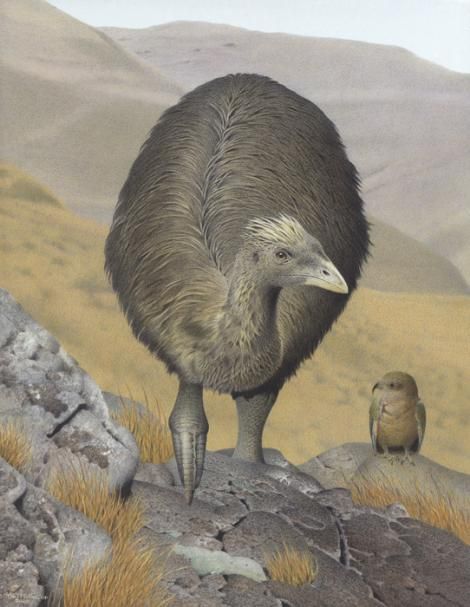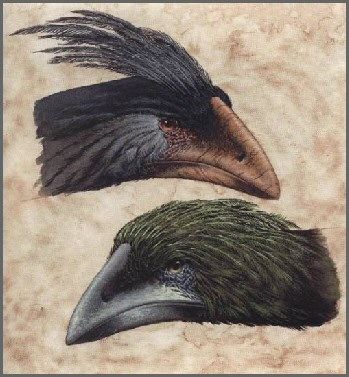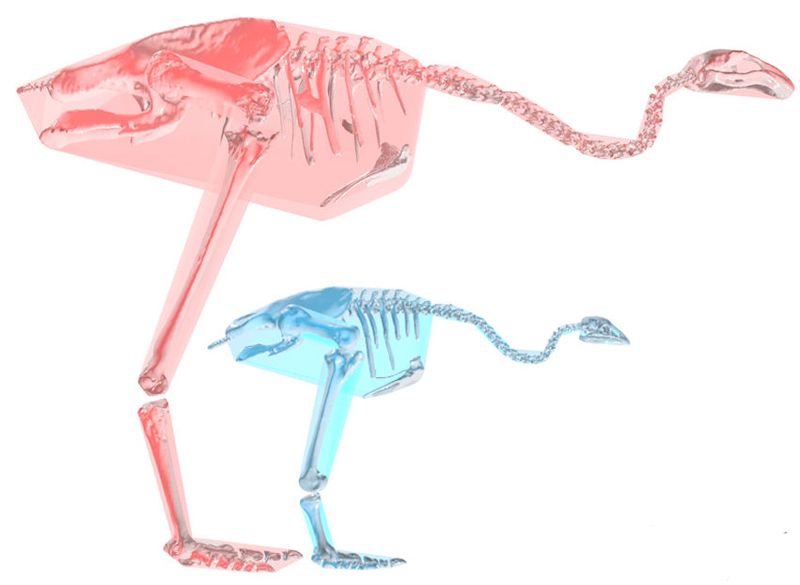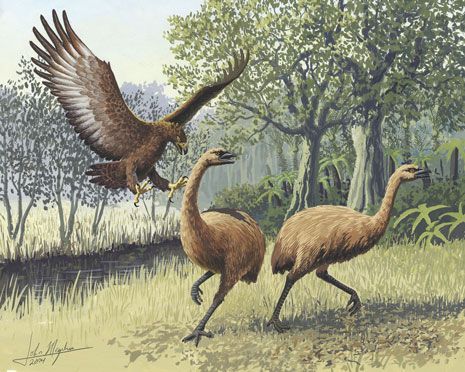Post by Eaglehawk on Jul 8, 2019 12:43:00 GMT
Crested Moa - Pachyornis australis

Conservation status: Extinct
Scientific classification
Kingdom:Animalia
Phylum:Chordata
Class:Aves
Superorder:Paleognathae
Order:Dinornithiformes
Family:Anomalopteryginae
Genus:Pachyornis
Species:Pachyornis australis
The Crested Moa, Pachyornis australis, is a species of Moa from the family Dinornithidae. It is one of the 11 known species of Moa to have existed. Moa are grouped together with emus, ostriches, kiwis, cassowaries, rheas, and tinamous in the clade Palaeognathae. Some of the species of this group are flightless and lacks a keel on their sternum. The name Crested Moa is due to pits being found in their skulls, suggesting they had crests. These cranial pits are also found occasionally in Dinornis, Anomalopteryx, and other Pachyornis species.

Description
The Crested Moa weighed around 50 kg (110 lb). The crested moa was smaller than the Heavy-footed Moa (Pachyornis elephantopus) and their bones are sometimes mistaken for those of P. elephantopus due to their similar structure.
Distribution and habitat
The Crested Moa was endemic to the South Island of New Zealand, where it occupied the high altitude sub-alpine forests in the North West. It was the ecological equivalent of the Heavy-footed Moa in the subalpine zone. While their remains have occasionally been found together,the heavy-footed moa generally preferred warmer and dryer lowland areas.
Ecology and diet
As with all Moa species, the Crested Moa filled the role of large herbivores in New Zealand, where there are no native terrestrial mammals. The only real threat of predation came from the Haast's Eagle (Harpagornis moorei).
Extinction
Until recently it was thought that the Crested Moa became extinct at the Pleistocene-Holocene transition roughly 10,000 years ago (10,000 years BP) during a period of significant climatic upheaveal. In 2012 however radiocarbon dating of Crested Moa remains from Bulmer Cavern showed that the specimen died between 1396 and 1442 AD, over 100 years after humans first settled on the Island. During the climatic changes before the settlers arrived, the Crested Moa followed the changes in elevation of their sub-alpine habitats with little change in their population size. Their extinction (along with all of the other species of Moa) relatively soon after the arrival of humans suggests that overhunting and habitat destruction were responsible. It is thought that the last of the Crested Moa survived in habitats that were less easily accessed by humans.
[/quote]
Extinct Giant Moa Bird Loses Weight, Strength, in New Study
By Laura Poppick, Staff Writer | December 18, 2013 07:01pm ET

A computer model of D. robustus (pink) next to the much smaller but more skeletally robust P. australis.
The extinct giant moa — one of the tallest birds that ever lived — may not have been as massive and strong-boned as previously thought, according to new research.
The scientific name of the giant moa — Dinornis robustus — translates to "robust strange bird," and the species was the largest of at least nine moa bird species that roamed New Zealand's jungles and shrublands for thousands of years, until going extinct about 500 years ago, likely due to overhunting.
The giant birds looked much like ostriches and emus do today; but their skeletal remains show they would have towered over their cousins, reaching about 12 feet (3.7 meters) tall, which is nearly double the height of modern ostriches.
While skeletal remains reveal the height of the bird, they do not tell the complete story of its body massand how it maneuvered its big bones. Researchers have tried to extrapolate the giant moa's body mass based on the relationship of bone diameter and body masses of modern birds, and also by creating soft tissue reconstructions of the birds using computer models. But both of these estimates produce problematic results, says a team of researchers based at the University of Manchester in the U.K. who recently worked to revise the body mass estimates of the bird.
Large legs, less mass
For one, the birds had particularly large legs, so comparing the ratios of bone diameter to body mass with those of modern birds will likely produce overestimates of body mass, study co-author Charlotte Brassey told LiveScience.
The same is true when scientists try to create soft tissue reconstructions.

A CT scan of D. robustus (left) and P. australis (right) leg bones, scaled to be the same size. Although D. robustus was four-times heavier than P. australis, its leg bones were comparatively thinner and less robust.
"The problem is you have to guess how much soft tissues these animals would have had," Brassey said. "Would they be plump, would they be skinny? These are all sources of potential error that you produce."
To calculate a better estimate of the bird's body mass and the maximum load that its large bones could bear, the researchers brought full skeletons of the giant moa into a hospital and conducted computed tomography (CT) scansof the bones — similar to those conducted on people with broken bones — to obtain digital images of the entire skeleton. They did the same for a much-smaller moa species called Pachyornis australis, for comparison.
The researchers then digitally shrink-wrapped the CT scans of both skeletons to estimate their body masses.
The resulting calculations showed that D. robustus was less hefty than previously thought, weighing roughly 440 lbs. (200 kg) rather than past estimates of around 510 lbs. (230 kg). Calculations of P. australis's mass suggested that itweighed just 110 lbs. (50 kg).
Crash-testing skeletons
The team used a computer program to digitally crash-test the birds to determine the amount of force their bones could withstand, and found that P. australis could, surprisingly, withstand more force and was therefore more robust than its larger counterpart erroneously named for the robustness of its bones, the team reports today (Dec. 18) in the journal PLOS ONE.
The team speculates that P. australis may have evolved to have more robust bones to make up for a speedier, more active lifestyle than D. robustus, which may have led a more sluggish life that required less-intense bone impact.
"We kind of assumed that if they were living at the same time that these two species would be similar, and the leg bones would be adapted to the particular environment they were living in," Brassey said. "But it appears that was not the case, and that these two moa birds took on very different forms."
The researchers plan to use their data to try to simulate the locomotion of the birds in order to understand better the birds' lifestyles and how they moved in their environment. This will help build on a growing body of research exploring how other gigantic animals, such as dinosaurs, adapted to accommodate large bodies, Brassey said.
www.livescience.com/42076-giant-moa-loses-weight.html
More than One Way of Being a Moa: Differences in Leg Bone Robustness Map Divergent Evolutionary Trajectories in Dinornithidae and Emeidae (Dinornithiformes)
Charlotte A. Brasse, Richard N. Holdaway, Abigail G. Packham, Jennifer Anné, Philip L. Manning, William I. Sellers
Published: December 18, 2013DOI: 10.1371/journal.pone.0082668
Abstract
The extinct moa of New Zealand included three families (Megalapterygidae; Dinornithidae; Emeidae) of flightless palaeognath bird, ranging in mass from <15 kg to >200 kg. They are perceived to have evolved extremely robust leg bones, yet current estimates of body mass have very wide confidence intervals. Without reliable estimators of mass, the extent to which dinornithid and emeid hindlimbs were more robust than modern species remains unclear. Using the convex hull volumetric-based method on CT-scanned skeletons, we estimate the mass of a female Dinornis robustus (Dinornithidae) at 196 kg (range 155–245 kg) and of a female Pachyornis australis (Emeidae) as 50 kg (range 33–68 kg). Finite element analysis of CT-scanned femora and tibiotarsi of two moa and six species of modern palaeognath showed that P. australis experienced the lowest values for stress under all loading conditions, confirming it to be highly robust. In contrast, stress values in the femur of D. robustus were similar to those of modern flightless birds, whereas the tibiotarsus experienced the highest level of stress of any palaeognath. We consider that these two families of Dinornithiformes diverged in their biomechanical responses to selection for robustness and mobility, and exaggerated hindlimb strength was not the only successful evolutionary pathway.

Table 4. Body mass estimates of moa individuals.
www.plosone.org/article/info%3Adoi%2F10.1371%2Fjournal.pone.0082668
Humans to Blame for Giant Bird's Extinction
By Megan Gannon, News Editor | March 24, 2014 09:31am ET

An artist's rendition of an eagle attacking two extinct New Zealand moa.
Fossils are all that's left of the giant wingless birds called moa that once roamed New Zealand. These big-bodied megaherbivores, some of them weighing up to 550 pounds (250 kilograms), disappeared soon after Polynesians colonized the islands in the late 13th century.
Some researchers had argued the nine species of moa were already in decline by the time humans entered the scene. Others had proposed the birds' population collapsed in the wake of volcanic eruptions or the spread of diseases, before they ever met Homo sapiens. A new study, however, suggests humans are responsible for the birds' demise.
"Elsewhere the situation may be more complex, but in the case of New Zealand the evidence provided by ancient DNA is now clear: The megafaunal extinctions were the result of human factors," Mike Bunce, a professor at Curtin University in Australia, said in a statement.
By looking at the genetic profiles of 281 individual fossil specimens, Bunce and colleagues pieced together the demographic trends across four different species of moa during the 5,000 years leading up to their extinction. They say they found no genetic signatures of decline.
On the contrary, genetic diversity remained consistent and the moa gene pools were "extremely stable throughout their last 5,000 years," said Morten Allentoft, who was a doctoral student in Bunce's lab.
One species, the South Island giant moa (Dinornis robustus), even seemed to be experiencing a population boom with as many as 9,200 individuals roaming about by the time Polynesians landed on New Zealand's shores.
"If anything it looks like their populations were increasing and viable when humans arrived," Allentoft said in a statement. "Then they just disappeared."
Archaeological evidence shows that moa were hunted voraciously and vanished just one or two centuries after humans showed up in New Zealand. In addition to overhunting, other indirect human impacts could have contributed to the moa's quick decline, including fires and the introduction of invasive species.
Bunce believes there are lessons to be learned from the moa's extinction.
"As a community we need to be more aware of the impacts we are having on the environment today and what we, as a species, are responsible for in the past," Bunce said.
The research was detailed this month in the Proceedings of the National Academy of Sciences.
www.livescience.com/44291-humans-to-blame-for-giant-birds-extinction.html
Extinct New Zealand megafauna were not in decline before human colonization
Morten Erik Allentofta, Rasmus Hellerd, Charlotte L. Oskamb, Eline D. Lorenzena, Marie L. Halec, M. Thomas P. Gilberta, Christopher Jacombg, Richard N. Holdawayc, and Michael Bunceb,
10.1073/pnas.1314972111
PNAS March 17, 2014
Abstract
The extinction of New Zealand's moa (Aves: Dinornithiformes) followed the arrival of humans in the late 13th century and was the final event of the prehistoric Late Quaternary megafauna extinctions. Determining the state of the moa populations in the pre-extinction period is fundamental to understanding the causes of the event. We sampled 281 moa individuals and combined radiocarbon dating with ancient DNA analyses to help resolve the extinction debate and gain insights into moa biology. The samples, which were predominantly from the last 4,000 years preceding the extinction, represent four sympatric moa species excavated from five adjacent fossil deposits. We characterized the moa assemblage using mitochondrial DNA and nuclear microsatellite markers developed specifically for moa. Although genetic diversity differed significantly among the four species, we found that the millennia preceding the extinction were characterized by a remarkable degree of genetic stability in all species, with no loss of heterozygosity and no shifts in allele frequencies over time. The extinction event itself was too rapid to be manifested in the moa gene pools. Contradicting previous claims of a decline in moa before Polynesian settlement in New Zealand, our findings indicate that the populations were large and stable before suddenly disappearing. This interpretation is supported by approximate Bayesian computation analyses. Our analyses consolidate the disappearance of moa as the most rapid, human-facilitated megafauna extinction documented to date.
www.pnas.org/content/early/2014/03/14/1314972111.abstract?sid=254b1b61-3836-4822-a2c5-2e211ec614b2


